School Violence: Causes, Interventions, and Crisis Response Committee
VerifiedAdded on 2022/07/28
|5
|1243
|453
Report
AI Summary
This report delves into the multifaceted issue of school violence, examining its various forms, underlying causes, and potential solutions. It begins by analyzing the roles of bullying, cyberbullying, and estranged violent juvenile offenders in contributing to a climate of fear and insecurity within schools. The report then explores different types of intervention programs that can be implemented, including individual, family, and community-level strategies, and outlines the steps involved in developing and executing an effective intervention plan. Finally, it identifies the key members of a school's crisis response committee and clarifies their respective responsibilities in managing and mitigating the impact of school-related crises. The report utilizes research studies to support its arguments and offers practical insights for educators, administrators, and policymakers seeking to create safer and more supportive school environments. The report is provided by a student to be published on Desklib, a platform which provides all the necessary AI based study tools for students.
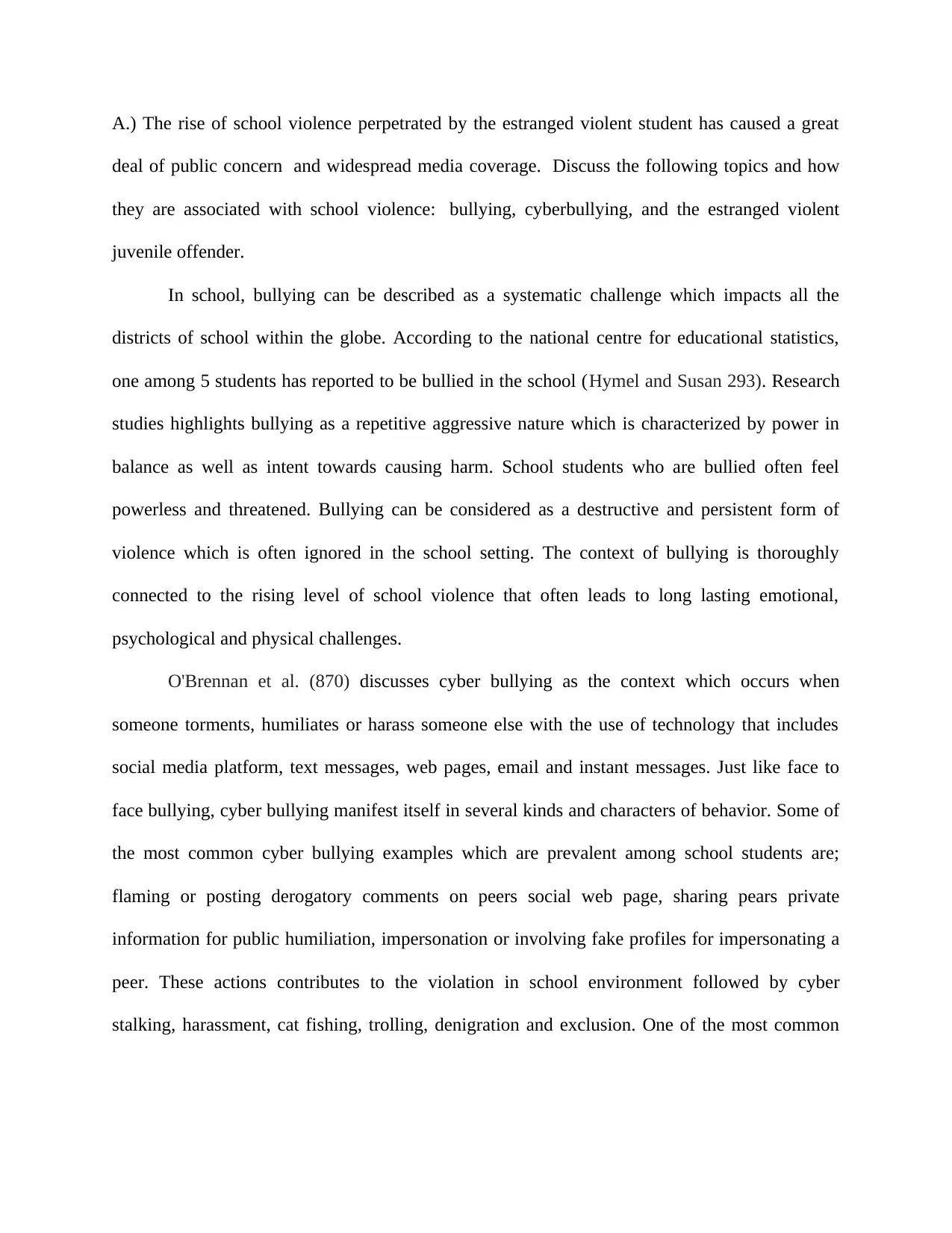
A.) The rise of school violence perpetrated by the estranged violent student has caused a great
deal of public concern and widespread media coverage. Discuss the following topics and how
they are associated with school violence: bullying, cyberbullying, and the estranged violent
juvenile offender.
In school, bullying can be described as a systematic challenge which impacts all the
districts of school within the globe. According to the national centre for educational statistics,
one among 5 students has reported to be bullied in the school (Hymel and Susan 293). Research
studies highlights bullying as a repetitive aggressive nature which is characterized by power in
balance as well as intent towards causing harm. School students who are bullied often feel
powerless and threatened. Bullying can be considered as a destructive and persistent form of
violence which is often ignored in the school setting. The context of bullying is thoroughly
connected to the rising level of school violence that often leads to long lasting emotional,
psychological and physical challenges.
O'Brennan et al. (870) discusses cyber bullying as the context which occurs when
someone torments, humiliates or harass someone else with the use of technology that includes
social media platform, text messages, web pages, email and instant messages. Just like face to
face bullying, cyber bullying manifest itself in several kinds and characters of behavior. Some of
the most common cyber bullying examples which are prevalent among school students are;
flaming or posting derogatory comments on peers social web page, sharing pears private
information for public humiliation, impersonation or involving fake profiles for impersonating a
peer. These actions contributes to the violation in school environment followed by cyber
stalking, harassment, cat fishing, trolling, denigration and exclusion. One of the most common
deal of public concern and widespread media coverage. Discuss the following topics and how
they are associated with school violence: bullying, cyberbullying, and the estranged violent
juvenile offender.
In school, bullying can be described as a systematic challenge which impacts all the
districts of school within the globe. According to the national centre for educational statistics,
one among 5 students has reported to be bullied in the school (Hymel and Susan 293). Research
studies highlights bullying as a repetitive aggressive nature which is characterized by power in
balance as well as intent towards causing harm. School students who are bullied often feel
powerless and threatened. Bullying can be considered as a destructive and persistent form of
violence which is often ignored in the school setting. The context of bullying is thoroughly
connected to the rising level of school violence that often leads to long lasting emotional,
psychological and physical challenges.
O'Brennan et al. (870) discusses cyber bullying as the context which occurs when
someone torments, humiliates or harass someone else with the use of technology that includes
social media platform, text messages, web pages, email and instant messages. Just like face to
face bullying, cyber bullying manifest itself in several kinds and characters of behavior. Some of
the most common cyber bullying examples which are prevalent among school students are;
flaming or posting derogatory comments on peers social web page, sharing pears private
information for public humiliation, impersonation or involving fake profiles for impersonating a
peer. These actions contributes to the violation in school environment followed by cyber
stalking, harassment, cat fishing, trolling, denigration and exclusion. One of the most common
Paraphrase This Document
Need a fresh take? Get an instant paraphrase of this document with our AI Paraphraser
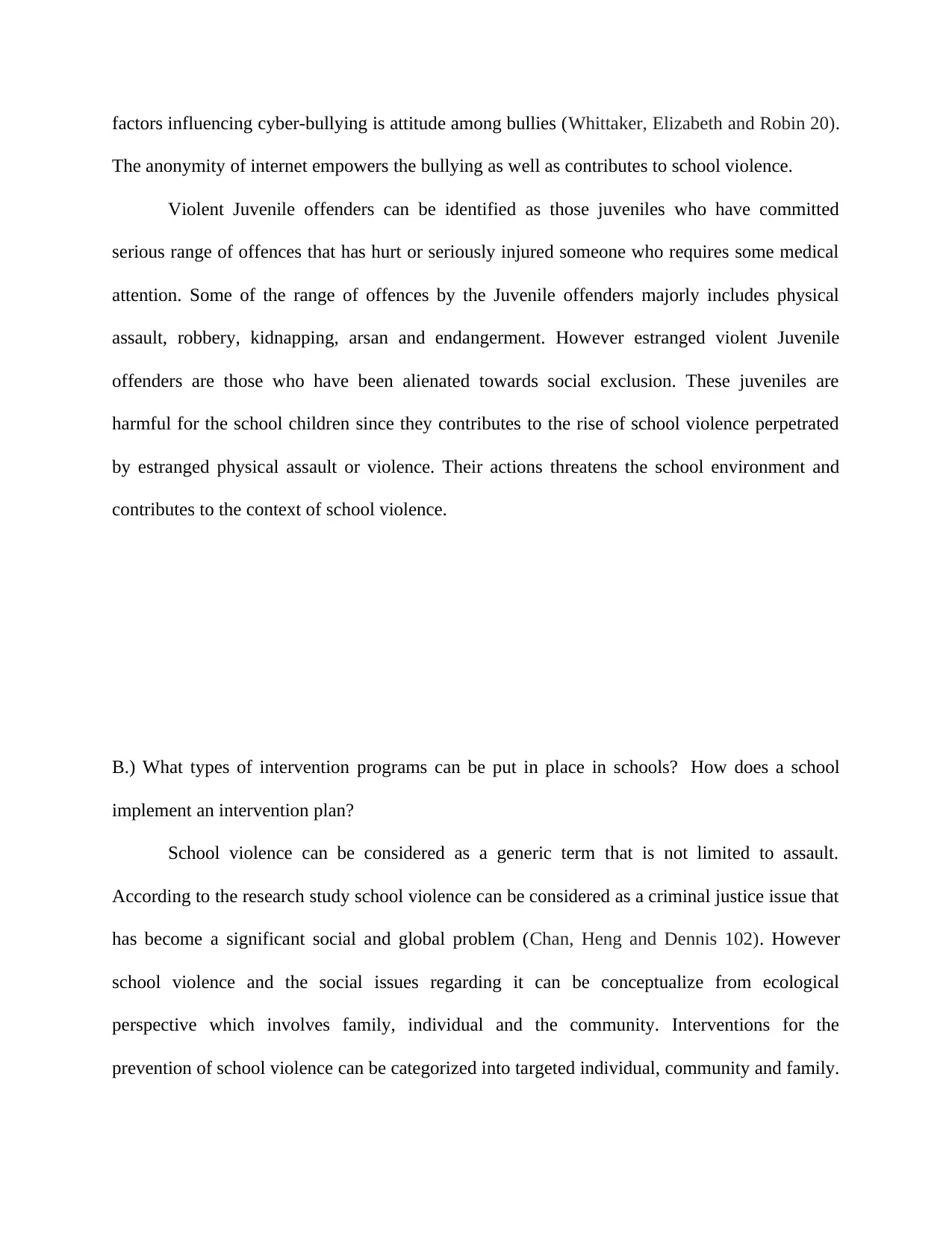
factors influencing cyber-bullying is attitude among bullies (Whittaker, Elizabeth and Robin 20).
The anonymity of internet empowers the bullying as well as contributes to school violence.
Violent Juvenile offenders can be identified as those juveniles who have committed
serious range of offences that has hurt or seriously injured someone who requires some medical
attention. Some of the range of offences by the Juvenile offenders majorly includes physical
assault, robbery, kidnapping, arsan and endangerment. However estranged violent Juvenile
offenders are those who have been alienated towards social exclusion. These juveniles are
harmful for the school children since they contributes to the rise of school violence perpetrated
by estranged physical assault or violence. Their actions threatens the school environment and
contributes to the context of school violence.
B.) What types of intervention programs can be put in place in schools? How does a school
implement an intervention plan?
School violence can be considered as a generic term that is not limited to assault.
According to the research study school violence can be considered as a criminal justice issue that
has become a significant social and global problem (Chan, Heng and Dennis 102). However
school violence and the social issues regarding it can be conceptualize from ecological
perspective which involves family, individual and the community. Interventions for the
prevention of school violence can be categorized into targeted individual, community and family.
The anonymity of internet empowers the bullying as well as contributes to school violence.
Violent Juvenile offenders can be identified as those juveniles who have committed
serious range of offences that has hurt or seriously injured someone who requires some medical
attention. Some of the range of offences by the Juvenile offenders majorly includes physical
assault, robbery, kidnapping, arsan and endangerment. However estranged violent Juvenile
offenders are those who have been alienated towards social exclusion. These juveniles are
harmful for the school children since they contributes to the rise of school violence perpetrated
by estranged physical assault or violence. Their actions threatens the school environment and
contributes to the context of school violence.
B.) What types of intervention programs can be put in place in schools? How does a school
implement an intervention plan?
School violence can be considered as a generic term that is not limited to assault.
According to the research study school violence can be considered as a criminal justice issue that
has become a significant social and global problem (Chan, Heng and Dennis 102). However
school violence and the social issues regarding it can be conceptualize from ecological
perspective which involves family, individual and the community. Interventions for the
prevention of school violence can be categorized into targeted individual, community and family.
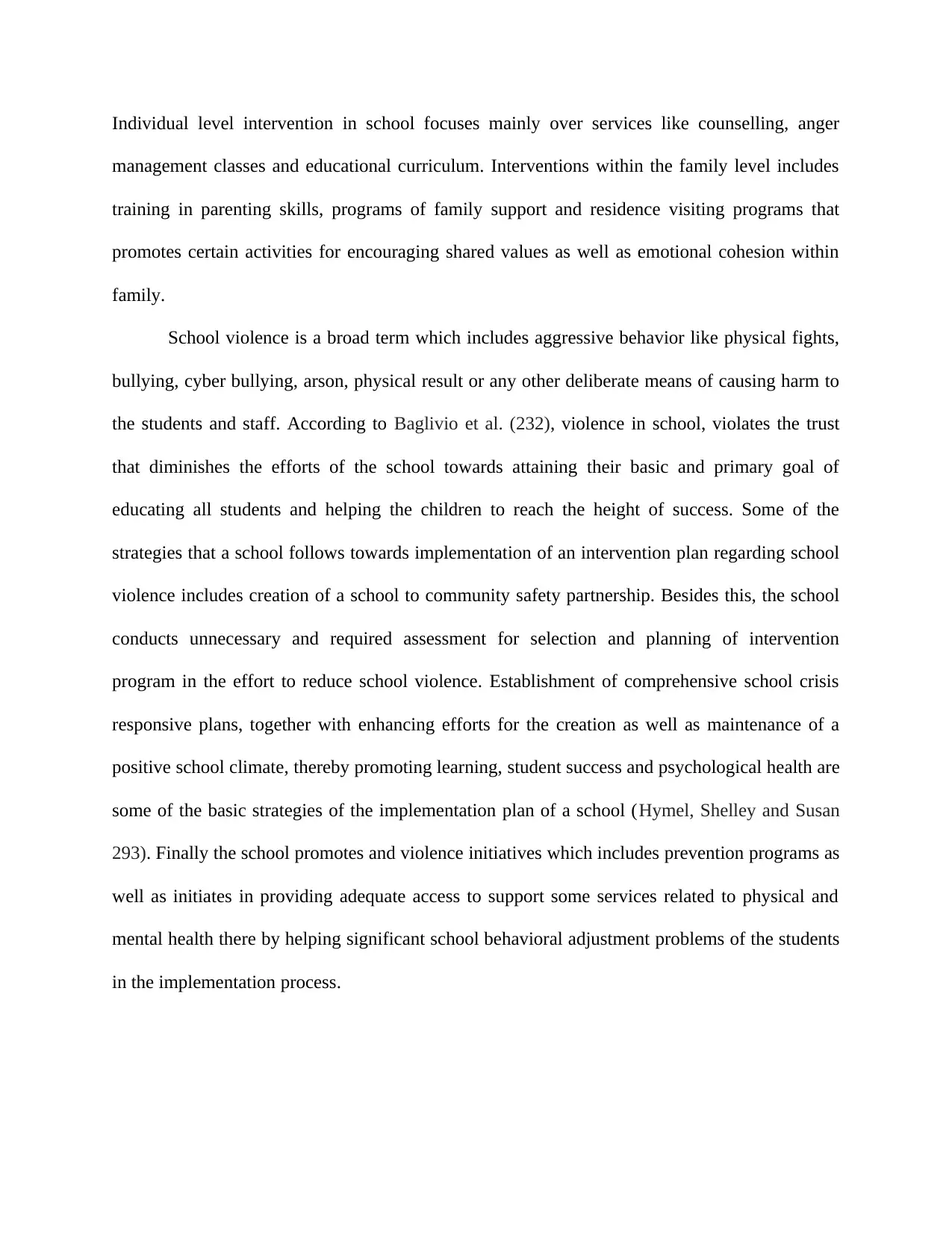
Individual level intervention in school focuses mainly over services like counselling, anger
management classes and educational curriculum. Interventions within the family level includes
training in parenting skills, programs of family support and residence visiting programs that
promotes certain activities for encouraging shared values as well as emotional cohesion within
family.
School violence is a broad term which includes aggressive behavior like physical fights,
bullying, cyber bullying, arson, physical result or any other deliberate means of causing harm to
the students and staff. According to Baglivio et al. (232), violence in school, violates the trust
that diminishes the efforts of the school towards attaining their basic and primary goal of
educating all students and helping the children to reach the height of success. Some of the
strategies that a school follows towards implementation of an intervention plan regarding school
violence includes creation of a school to community safety partnership. Besides this, the school
conducts unnecessary and required assessment for selection and planning of intervention
program in the effort to reduce school violence. Establishment of comprehensive school crisis
responsive plans, together with enhancing efforts for the creation as well as maintenance of a
positive school climate, thereby promoting learning, student success and psychological health are
some of the basic strategies of the implementation plan of a school (Hymel, Shelley and Susan
293). Finally the school promotes and violence initiatives which includes prevention programs as
well as initiates in providing adequate access to support some services related to physical and
mental health there by helping significant school behavioral adjustment problems of the students
in the implementation process.
management classes and educational curriculum. Interventions within the family level includes
training in parenting skills, programs of family support and residence visiting programs that
promotes certain activities for encouraging shared values as well as emotional cohesion within
family.
School violence is a broad term which includes aggressive behavior like physical fights,
bullying, cyber bullying, arson, physical result or any other deliberate means of causing harm to
the students and staff. According to Baglivio et al. (232), violence in school, violates the trust
that diminishes the efforts of the school towards attaining their basic and primary goal of
educating all students and helping the children to reach the height of success. Some of the
strategies that a school follows towards implementation of an intervention plan regarding school
violence includes creation of a school to community safety partnership. Besides this, the school
conducts unnecessary and required assessment for selection and planning of intervention
program in the effort to reduce school violence. Establishment of comprehensive school crisis
responsive plans, together with enhancing efforts for the creation as well as maintenance of a
positive school climate, thereby promoting learning, student success and psychological health are
some of the basic strategies of the implementation plan of a school (Hymel, Shelley and Susan
293). Finally the school promotes and violence initiatives which includes prevention programs as
well as initiates in providing adequate access to support some services related to physical and
mental health there by helping significant school behavioral adjustment problems of the students
in the implementation process.
⊘ This is a preview!⊘
Do you want full access?
Subscribe today to unlock all pages.

Trusted by 1+ million students worldwide
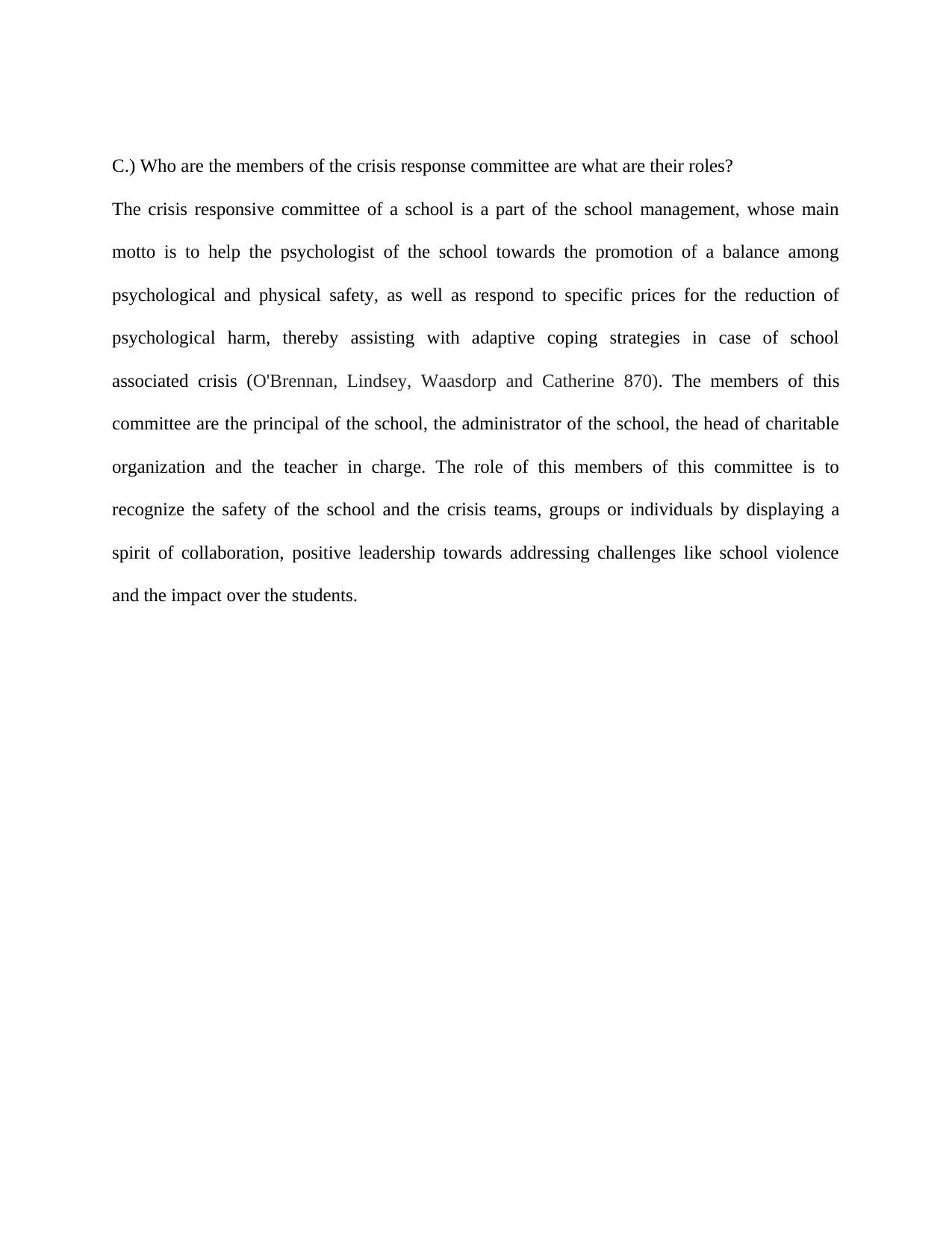
C.) Who are the members of the crisis response committee are what are their roles?
The crisis responsive committee of a school is a part of the school management, whose main
motto is to help the psychologist of the school towards the promotion of a balance among
psychological and physical safety, as well as respond to specific prices for the reduction of
psychological harm, thereby assisting with adaptive coping strategies in case of school
associated crisis (O'Brennan, Lindsey, Waasdorp and Catherine 870). The members of this
committee are the principal of the school, the administrator of the school, the head of charitable
organization and the teacher in charge. The role of this members of this committee is to
recognize the safety of the school and the crisis teams, groups or individuals by displaying a
spirit of collaboration, positive leadership towards addressing challenges like school violence
and the impact over the students.
The crisis responsive committee of a school is a part of the school management, whose main
motto is to help the psychologist of the school towards the promotion of a balance among
psychological and physical safety, as well as respond to specific prices for the reduction of
psychological harm, thereby assisting with adaptive coping strategies in case of school
associated crisis (O'Brennan, Lindsey, Waasdorp and Catherine 870). The members of this
committee are the principal of the school, the administrator of the school, the head of charitable
organization and the teacher in charge. The role of this members of this committee is to
recognize the safety of the school and the crisis teams, groups or individuals by displaying a
spirit of collaboration, positive leadership towards addressing challenges like school violence
and the impact over the students.
Paraphrase This Document
Need a fresh take? Get an instant paraphrase of this document with our AI Paraphraser
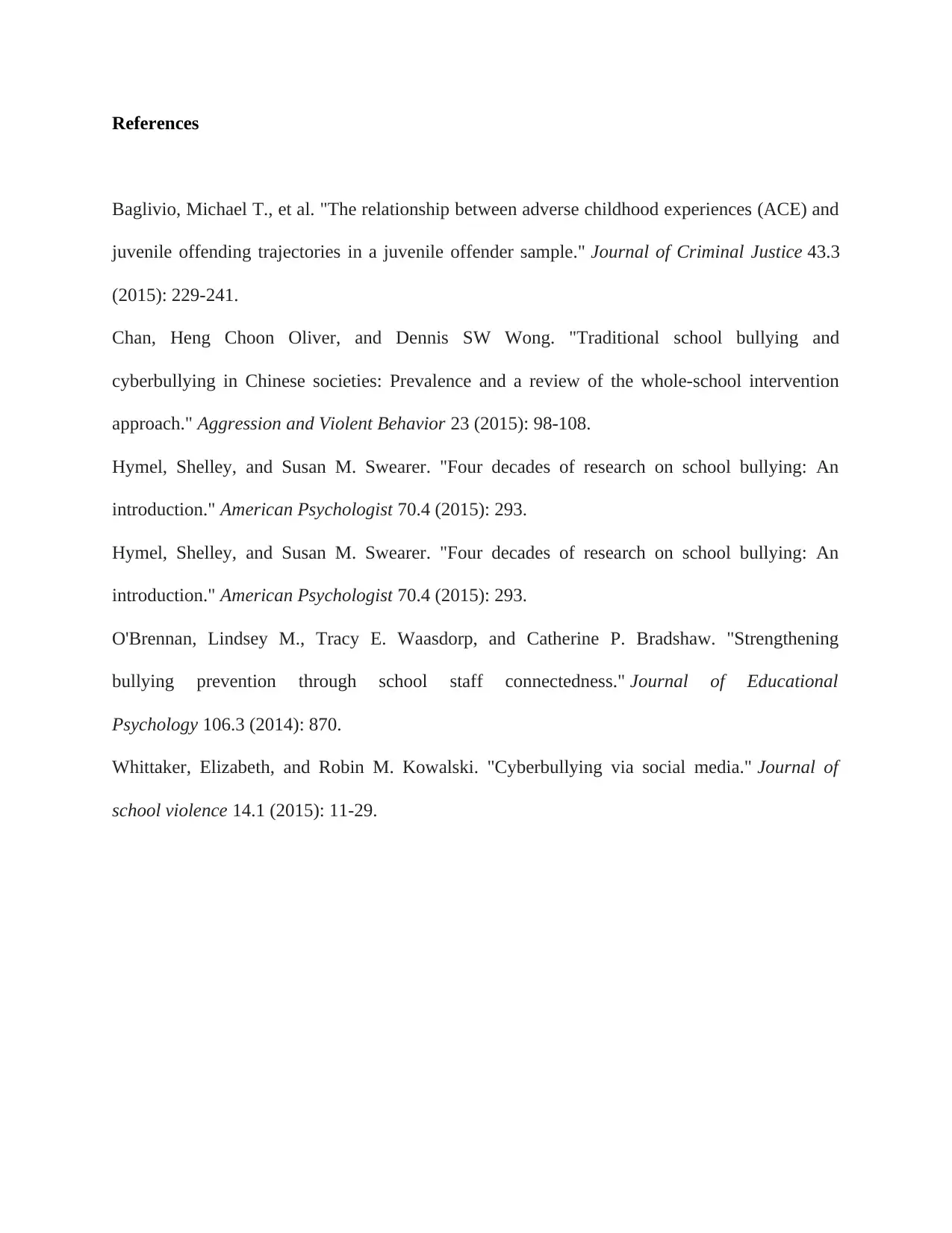
References
Baglivio, Michael T., et al. "The relationship between adverse childhood experiences (ACE) and
juvenile offending trajectories in a juvenile offender sample." Journal of Criminal Justice 43.3
(2015): 229-241.
Chan, Heng Choon Oliver, and Dennis SW Wong. "Traditional school bullying and
cyberbullying in Chinese societies: Prevalence and a review of the whole-school intervention
approach." Aggression and Violent Behavior 23 (2015): 98-108.
Hymel, Shelley, and Susan M. Swearer. "Four decades of research on school bullying: An
introduction." American Psychologist 70.4 (2015): 293.
Hymel, Shelley, and Susan M. Swearer. "Four decades of research on school bullying: An
introduction." American Psychologist 70.4 (2015): 293.
O'Brennan, Lindsey M., Tracy E. Waasdorp, and Catherine P. Bradshaw. "Strengthening
bullying prevention through school staff connectedness." Journal of Educational
Psychology 106.3 (2014): 870.
Whittaker, Elizabeth, and Robin M. Kowalski. "Cyberbullying via social media." Journal of
school violence 14.1 (2015): 11-29.
Baglivio, Michael T., et al. "The relationship between adverse childhood experiences (ACE) and
juvenile offending trajectories in a juvenile offender sample." Journal of Criminal Justice 43.3
(2015): 229-241.
Chan, Heng Choon Oliver, and Dennis SW Wong. "Traditional school bullying and
cyberbullying in Chinese societies: Prevalence and a review of the whole-school intervention
approach." Aggression and Violent Behavior 23 (2015): 98-108.
Hymel, Shelley, and Susan M. Swearer. "Four decades of research on school bullying: An
introduction." American Psychologist 70.4 (2015): 293.
Hymel, Shelley, and Susan M. Swearer. "Four decades of research on school bullying: An
introduction." American Psychologist 70.4 (2015): 293.
O'Brennan, Lindsey M., Tracy E. Waasdorp, and Catherine P. Bradshaw. "Strengthening
bullying prevention through school staff connectedness." Journal of Educational
Psychology 106.3 (2014): 870.
Whittaker, Elizabeth, and Robin M. Kowalski. "Cyberbullying via social media." Journal of
school violence 14.1 (2015): 11-29.
1 out of 5
Your All-in-One AI-Powered Toolkit for Academic Success.
+13062052269
info@desklib.com
Available 24*7 on WhatsApp / Email
![[object Object]](/_next/static/media/star-bottom.7253800d.svg)
Unlock your academic potential
Copyright © 2020–2025 A2Z Services. All Rights Reserved. Developed and managed by ZUCOL.


